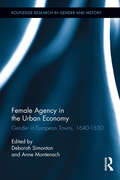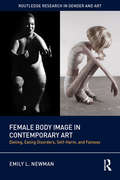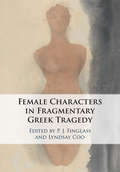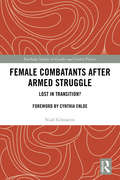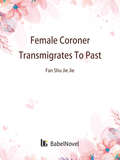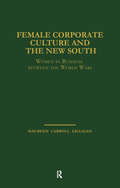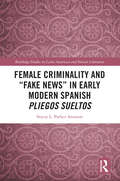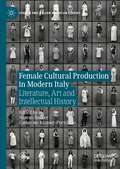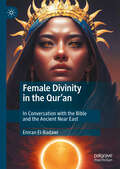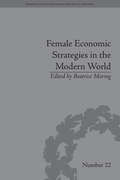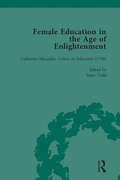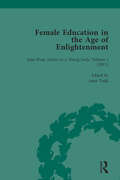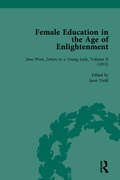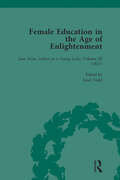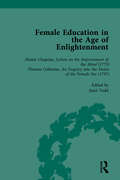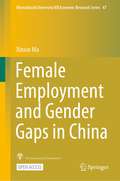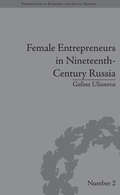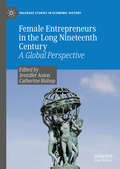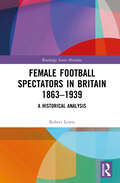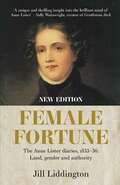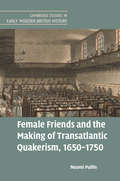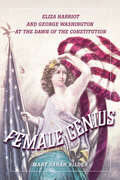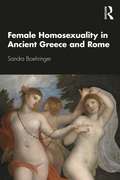- Table View
- List View
Female Agency in the Urban Economy: Gender in European Towns, 1640-1830 (Routledge Research in Gender and History #14)
by Deborah Simonton Anne MontenachThis innovative new book is overtly and explicitly about female agency in eighteenth-century European towns. However, it positions female activity and decisions unequivocally in an urban world of institutions, laws, regulations, customs and ideologies. Gender politics complicated and shaped the day-to-day experiences of working women. Town rules and customs, as well as police and guilds’ regulations, affected women’s participation in the urban economy: most of the time, the formally recognized and legally accepted power of women – which is an essential component of female agency – was very limited. Yet these chapters draw attention to how women navigated these gendered terrains. As the book demonstrates, "exclusion" is too strong a word for the realities and pragmatism of women’s everyday lives. Frequently guild and corporate regulations were more about situating women and regulating their activities, rather than preventing them from operating in the urban economy. Similarly corporate structures, which were under stress, found flexible strategies to incorporate women who through their own initiative and activities put pressure on the systems. Women could benefit from the contradictions between moral and social unwritten norms and economic regulations, and could take advantage of the tolerance or complicity of urban authorities towards illicit practices. Women with a grasp of their rights and privileges could defend themselves and exploit legal systems with its loopholes and contradictions to achieve economic independence and power.
Female Alliances
by Amanda E. HerbertIn the late seventeenth and early eighteenth centuries, cultural, economic, and political changes, as well as increased geographic mobility, placed strains upon British society. But by cultivating friendships and alliances, women worked to socially cohere Britain and its colonies. In the first book-length historical study of female friendship and alliance for the early modern period, Amanda Herbert draws on a series of interlocking microhistorical studies to demonstrate the vitality and importance of bonds formed between British women in the long eighteenth century. She shows that while these alliances were central to women’s lives, they were also instrumental in building the British Atlantic world.
Female Body Image in Contemporary Art: Dieting, Eating Disorders, Self-Harm, and Fatness (Routledge Research in Gender and Art)
by Emily L. NewmanNumerous contemporary artists, particularly female artists, have chosen to examine the idealization of the female body. In this crucial book, Emily L. Newman focuses on a number of key themes including obesity, anorexia, bulimia, dieting, self-harm, and female body image. Many artists utilize their own bodies in their work, and in the act of trying to critique the diet industry, they also often become complicit, as they strive to lose weight themselves. Making art and engaging eating disorder communities (in real life and online) often work to perpetuate the illnesses of themselves or others. A core group of artists has worked to show bodies that are outside the norm, paralleling the rise of fat activism in the 1990s and 2000s. Interwoven throughout this inclusive study are related interdisciplinary concerns including sociology, popular culture, and feminism.
Female Characters in Fragmentary Greek Tragedy
by P. J. Finglass Lyndsay CooHow were women represented in Greek tragedy? This question lies at the heart of much modern scholarship on ancient drama, yet it has typically been approached using evidence drawn only from the thirty-two tragedies that survive complete - neglecting tragic fragments, especially those recently discovered and often very substantial fragmentary papyri from plays that had been thought lost. Drawing on the latest research on both gender in tragedy and on tragic fragments, the essays in this volume examine this question from a fresh perspective, shedding light on important mythological characters such as Pasiphae, Hypsipyle, and Europa, on themes such as violence, sisterhood, vengeance, and sex, and on the methodology of a discipline which needs to take fragmentary evidence to heart in order to gain a fuller understanding of ancient tragedy. All Greek is translated to ensure wide accessibility.
Female Combatants after Armed Struggle: Lost in Transition? (Routledge Studies in Gender and Global Politics)
by Niall GilmartinThis book stems from a simple ‘feminist curiosity’ that can be succinctly summed up into a single question: what happens to combatant women after the war? Based on in-depth interviews with 40 research participants, mostly former combatants within the Irish Republican Army (IRA), this book offers a critical exploration of republican women and conflict transition in the North of Ireland. Drawing on the feminist theory of a continuum of violence, this book finds that the dichotomous separation of war and peace within conventional approaches represents a gendered fiction. Despite undertaking wartime roles that were empowering, agentic, and subversive, this book finds that the ‘post-conflict moment’ as experienced by female combatants represents not peace and security, but a continuity of gender discrimination, violence, injustice, and insecurity. The experiences and perspectives contained in this book challenge the discursive deployment of terms such as post-conflict, peace, and security, and moreover, shed light on the many forms of post-war activism undertaken by combatant women in pursuit of peace, equality, and security. The book represents an important intervention in the field of gender, political violence, and peace, and more specifically, female combatants and conflict transition. It is analytically significant in its exploration of the ways in which gender operates within non-state military movements emerging from conflict, and will be of interest to students and scholars alike.
Female Coroner Transmigrates To Past: Volume 1 (Volume 1 #1)
by Zhenyinfangthe crossing of female forensic medicine
Female Corporate Culture and the New South: Women in Business Between the World Wars (Garland Studies in the History of American Labor)
by Maureen Carroll GilliganFirst Published in 1999. Routledge is an imprint of Taylor & Francis, an informa company.
Female Criminality and “Fake News” in Early Modern Spanish Pliegos Sueltos (Routledge Studies in Latin American and Iberian Literature)
by Stacey L. Parker AronsonThis book studies the Early Modern Spanish broadsheet, the tabloid newspaper of its day which functioned to educate, entertain, and indoctrinate its readers, much like today’s "fake news." Parker Aronson incorporates a socio-historical approach in which she considers crime and deviance committed by women in Early Modern Spain and the correlation between crime and the growth of urban centers. She also considers female deviance more broadly to encompass sexual and religious deviance while investigating the relationship between these pliegos sueltos and the transgressive and disruptive nature of female criminality. In addition to an introduction to this fascinating subgenre of Early Modern Spanish literature, Parker Aronson analyzes the representations of women as bandits and highway robbers; as murderers; as prostitutes, libertines, and actors; as Christian renegades; as enlaved people; as witches; as miscegenationists; and as the recipients of punishment.
Female Cultural Production in Modern Italy: Literature, Art and Intellectual History (Italian and Italian American Studies)
by Sharon Hecker Catherine Ramsey-PortolanoThis book is the first critical interdisciplinary examination in English of Italian women’s contributions to intellectual, artistic, and cultural production in modern Italy. Examining commonalities and diversities from the country’s Unification to today, the volume provides insight into the challenges that Italian women engaged in cultural production have faced, and the strategies they have deployed in order to achieve their objectives. The essays address a range of issues, from women’s self-identification and public ownership of their professional roles as laborers in the intellectual and cultural realm, to questions about motherhood and financial remuneration, to the role of creative foreign women in Italy. Through critical analysis and direct testimony from new and typically marginalized voices, including an Arab-Italian writer, an Italian-Dominican filmmaker, and a transgender activist, new forms of ongoing struggle emerge that redefine the culturally diverse landscape of female intellectual and creative production in Italy today. The volume rethinks a solely national “Made in Italy” reading of the subject of female intellectual labor, demonstrating instead the wide network of influences and relationships that have existed for Italian women in their professional aspirations.
Female Divinity in the Qur’an: In Conversation with the Bible and the Ancient Near East
by Emran El-BadawiThis is the first book to examine how pre-Islamic/Late Antique goddesses shaped the Qur’an, including its basic theology and cosmology. Exploring the traces found in the text of cultic veneration to goddesses of Arabia and the Ancient Near East, this book analyses what these traces tell us about female power in late antique Arabia, and how this power changed on the advent of Islam. While recent studies on the Qur’anic God have typically considered the question of divinity separately from gender, this book bridges the gap between these two questions, and is therefore an essential constructive mission. This mission adduces literary and documentary evidence—including recent scholarly revolutions in Syriac literature and Arabian epigraphy—and builds upon the critical insights of preceding studies in conversation with post-biblical and Near Eastern traditions.
Female Economic Strategies in the Modern World (Perspectives in Economic and Social History #22)
by Beatrice MoringThis collection of essays looks at the various ways in which women have coped financially in a male-dominated world. Chapters focus on Europe and Latin America, and cover the whole of the modern period.
Female Education in the Age of Enlightenment, vol 3
by Janet ToddBoth men and women took part in the education debate that culminated in the 1790s with Wollstonecraft, More and Edgeworth, but positions and arguments were laid down long before by Fordyce, Gregory, Gisbourne, West, Macaulay and Chapone, as featured in this text.
Female Education in the Age of Enlightenment, vol 4
by Janet ToddBoth men and women took part in the education debate that culminated in the 1790s with Wollstonecraft, More and Edgeworth, but positions and arguments were laid down long before by Fordyce, Gregory, Gisbourne, West, Macaulay and Chapone, as featured in this text.
Female Education in the Age of Enlightenment, vol 5
by Janet ToddBoth men and women took part in the education debate that culminated in the 1790s with Wollstonecraft, More and Edgeworth, but positions and arguments were laid down long before by Fordyce, Gregory, Gisbourne, West, Macaulay and Chapone, as featured in this text.
Female Education in the Age of Enlightenment, vol 6
by Janet ToddBoth men and women took part in the education debate that culminated in the 1790s with Wollstonecraft, More and Edgeworth, but positions and arguments were laid down long before by Fordyce, Gregory, Gisbourne, West, Macaulay and Chapone, as featured in this text.
Female Education in the Age of Enlightenment,vol 2
by Janet ToddBoth men and women took part in the education debate that culminated in the 1790s with Wollstonecraft, More and Edgeworth, but positions and arguments were laid down long before by Fordyce, Gregory, Gisbourne, West, Macaulay and Chapone, as featured in this text.
Female Employment and Gender Gaps in China (Hitotsubashi University IER Economic Research Series #48)
by Xinxin MaThis open access book investigates female employment and the gender gap in the labor market and households during China’s economic transition period. It provides the reader with academic evidence for understanding the mechanism of female labor force participation, the determinants of the gender gap in the labor market, and the impact of policy transformation on women’s wages and employment in China from an economics perspective. The main content of this book includes three parts―women’s family responsibilities and women’s labor supply (child care, parent care, and women’s employment), the gender gap in the labor market and society (gender gaps in wages, Communist Party membership, and participation in social activity), and the impacts of policy transformation on women’s wages and employment (the social security system and the educational expansion policy on women’s wages and employment) in China. This book provides academic evidence about these issues based on economics theories and econometric analysis methods using many kinds of long-term Chinese national survey data. This book is highly recommended to readers who are interested in up-to-date and in-depth empirical studies of the gender gap and women’s employment in China during the economic transition period. This book is of interest to various groups such as readers who are interested in the Chinese economy, policymakers, and scholars with econometric analysis backgrounds.
Female Entrepreneurs in Nineteenth-Century Russia (Perspectives in Economic and Social History #2)
by Galina UlianovaThis pioneering work comprehensively examines the history of female entrepreneurship in the Russian Empire during nineteenth-century industrial development.
Female Entrepreneurs in the Long Nineteenth Century: A Global Perspective (Palgrave Studies in Economic History)
by Jennifer Aston Catherine Bishop"This volume challenges those who see gender inequalities invariably defining and constraining the lives of women. But it also broadens the conversation about the degree to which business is a gender-blind institution, owned and managed by entrepreneurs whose gender identities shape and reflect economic and cultural change." – Mary A. Yeager, Professor Emerita, University of California, Los AngelesThis is the first book to consider nineteenth-century businesswomen from a global perspective, moving beyond European and trans-Atlantic frameworks to include many other corners of the world. The women in these pages, who made money and business decisions for themselves rather than as employees, ran a wide variety of enterprises, from micro-businesses in the ‘grey market’ to large factories with international reach. They included publicans and farmers, midwives and property developers, milliners and plumbers, pirates and shopkeepers. Female Entrepreneurs in the Long Nineteenth Century: A Global Perspective rejects the notion that nineteenth-century women were restricted to the home. Despite a variety of legal and structural restrictions, they found ways to make important but largely unrecognised contributions to economies around the world - many in business. Their impact on the economy and the economy’s impact on them challenge gender historians to think more about business and business historians to think more about gender and create a global history that is inclusive of multiple perspectives.Chapter one of this book is available open access under a CC BY 4.0 license at link.springer.com.
Female Football Spectators in Britain 1863-1939: A Historical Analysis (Routledge Soccer Histories)
by Robert LewisThis book analyses women as spectators at men’s association football (soccer) in Britain from 1863 to 1939. The author shows that women have always been present at men’s football in Britain, a fact not always acknowledged in modern popular accounts of the game, albeit as a small minority in overall attendances. Some women have always been ‘authentic’ fans of football, both knowledgeable and enthusiastic in their support, and this book will demonstrate that.
Female Fortune: The Anne Lister Diaries, 1833-36: Land, Gender and Authority
by Jill LiddingtonFemale Fortune is the book which inspired Sally Wainwright to write Gentleman Jack, now a major drama series for the BBC and HBO. <p><P> Lesbian landowner Anne Lister inherited Shibden Hall in 1826. She was an impressive scholar, fearless traveller and successful businesswoman, even developing her own coal mines. Her extraordinary diaries, running to 4-5 million words, were partly written in her own secret code and recorded her love affairs with startling candor. The diaries were included on UNESCO’s Memory of the World Register in 2011. <p><P> Jill Liddington’s classic edition of the diaries tells the story of how Anne Lister wooed and seduced neighbouring heiress Ann Walker, who moved in to live with Anne and her family in 1834. Politically active, Anne Lister door-stepped her tenants at the 1835 Election to vote Tory. And socially very ambitious, she employed architects to redesign both the Hall and the estate. <p><P> Yet Ann Walker had an inconvenient number of local relatives, suspicious of exactly how Anne Lister could pay for all her grand improvements. Tensions grew to a melodramatic crescendo when news reached Shibden of the pair being burnt in effigy. <p><P> This 2022 edition includes a fascinating Afterword on the recent discovery of Ann Walker’s own diary. Female Fortune is essential reading for those who watched Gentleman Jack and want to know more about the extraordinary woman that was Anne Lister.
Female Friends and the Making of Transatlantic Quakerism, 1650–1750 (Cambridge Studies In Early Modern British History )
by Naomi PullinQuaker women were unusually active participants in seventeenth- and eighteenth-century cultural and religious exchange, as ministers, missionaries, authors and spiritual leaders. <P><P>Drawing upon documentary evidence, with a focus on women's personal writings and correspondence, Naomi Pullin explores the lives and social interactions of Quaker women in the British Atlantic between 1650 and 1750. Through a comparative methodology, focused on Britain and the North American colonies, Pullin examines the experiences of both those women who traveled and preached and those who stayed at home. The book approaches the study of gender and religion from a new perspective by placing women's roles, relationships and identities at the centre of the analysis. It shows how the movement's transition from 'sect to church' enhanced the authority and influence of women within the movement and uncovers the multifaceted ways in which female Friends at all levels were active participants in making and sustaining transatlantic Quakerism.<P> The first comprehensive history of early transatlantic Quakerism Provides historical agency to women traditionally excluded from Quaker history.<P> Uses rich documentary evidence to reveal women's relationships within the family, the local Quaker community, as Friends, and with the non-Quaker world.
Female Friends: A Novel (Picador Bks.)
by Fay WeldonFrom bestselling author Fay Weldon comes the story of three women&’s enduring friendship They first met as children in 1940s London. Thirty years later, Marjorie, Chloe, and Grace make their way through an almost unrecognizable post-war society, coping with husbands, children, parents, and the messy business of life. Trapped by her dependency on her tormented screenwriter husband, Chloe finds a novel way of liberating herself from his sexual and domestic oppression. Marjorie, a childless BBC director, is overwhelmed with guilt upon seeing her mother, the woman who abandoned her thirty years earlier, dying in a hospital bed. And egocentric Grace, who lives with a much younger man, her husband having passed away, sacrifices the wellbeing of her son upon the altar of pleasure. A smart, prescient novel that speaks for a generation of women struggling to find their place in a male-dominated world, Female Friends is a masterwork from a storyteller at the top of her game.
Female Genius: Eliza Harriot and George Washington at the Dawn of the Constitution
by Mary Sarah BilderIn this provocative new biography, Mary Sarah Bilder looks to the 1780s—the Age of the Constitution—to investigate the rise of a radical new idea in the English-speaking world: female genius. Bilder finds the perfect exemplar of this phenomenon in English-born Eliza Harriot Barons O’Connor. This pathbreaking female educator delivered a University of Pennsylvania lecture attended by George Washington as he and other Constitutional Convention delegates gathered in Philadelphia. As the first such public female lecturer, her courageous performance likely inspired the gender-neutral language of the Constitution.Female Genius reconstructs Eliza Harriot’s transatlantic life, from Lisbon to Charleston, paying particular attention to her lectures and to the academies she founded, inspiring countless young American women to consider a college education and a role in the political forum. Promoting the ideas made famous by Mary Wollstonecraft, Eliza Harriot brought the concept of female genius to the United States. Its advocates argued that women had equal capacity and deserved an equal education and political representation. Its detractors, who feared it undermined male political power, felt deeply threatened. By 1792 Eliza Harriot experienced struggles that reflected the larger backlash faced by women and people of color as new written constitutions provided the political and legal tools for exclusion based on sex, gender, and race.In recovering this pioneering life, the richly illustrated Female Genius makes clear that America’s framing moment did not belong solely to white men and offers an inspirational transatlantic history of women who believed in education as a political right.
Female Homosexuality in Ancient Greece and Rome
by Sandra BoehringerThis groundbreaking study, among the earliest syntheses on female homosexuality throughout Antiquity, explores the topic with careful reference to ancient concepts and views, drawing fully on the existing visual and written record including literary, philosophical, and scientific documents. Even today, ancient female homosexuals are still too often seen in terms of a mythical, ethereal Sapphic love, or stereotyped as "Amazons" or courtesans. Boehringer's scholarly book replaces these clichés with rigorous, precise analysis of iconography and texts by Sappho, Plato, Ovid, Juvenal, and many other lyric poets, satirists, and astrological writers, in search of the prevailing norms, constraints, and possibilities for erotic desire. The portrait emerges of an ancient society to which today's sexual categories do not apply—a society "before sexuality"—where female homosexuality looks very different, but is nonetheless very real. Now available in English for the first time, Female Homosexuality in Ancient Greece and Rome includes a preface by David Halperin. This book will be of value to students and scholars of ancient sexuality and gender, and to anyone interested in histories and theories of sexuality.
